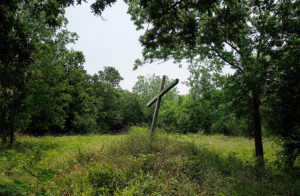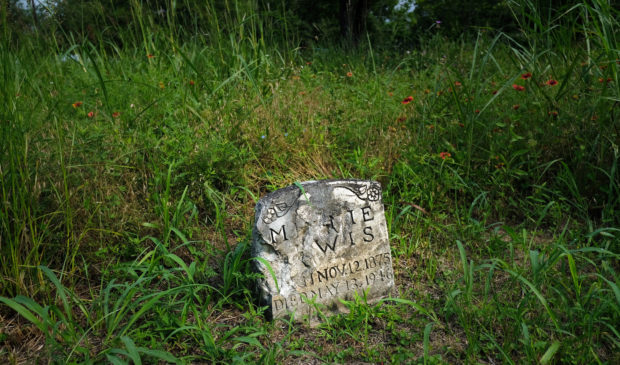Austin’s development battle goes underground
Tuesday, May 17, 2016 by
KUT News Rapid development is just about everywhere in Austin, and some of that development has brought up issues such as questions about environmental impact and concerns over increased traffic. But one developer has a fight on its hands that’s not about what’s happening above ground, but below.
At the small, overgrown Burditt Prairie Cemetery in Montopolis, headstones peek out from the grass and weeds. Adama Brown has been coming to this cemetery since she was a kid. A lot of her family members are buried here. The cemetery is named for a family that owned a cotton plantation on the land.
“My family members, ancestors, were slaves who worked the Burditt plantation and ended up taking the Burditt name,” Brown says.
Originally the cemetery was for enslaved people, like Brown’s ancestors. Later the area became a freedom colony — a self-sufficient community created by emancipated slaves. Burditt Prairie was the community’s cemetery. It’s still being used today, although upkeep is questionable.
Brown’s grandfather’s grave lies somewhere in the deep grass. Like a lot of graves here, it’s unmarked, and after searching for a while, Brown gives up — the grass is just too high for her to recognize the spot.
Brown is part of the cemetery association that looks after Burditt Prairie Cemetery, known as the Burditt Prairie Cemetery Covenant Association. The group is concerned because a developer is planning to build next to the cemetery, where there could be several unmarked graves.
Archaeologist Fred McGhee is also part of the cemetery association. As he works his way through the thigh-high weeds in the grounds behind the cemetery — the developer’s land — with his “big machete,” he points out a large mound in the ground.
It’s maybe 5 feet high, and, he says, it has “what looks like about an 8-foot cross sitting right on top of the hill. Now you don’t have to be an expert in mound builders to know that that looks pretty interesting.”

Burditt Prairie Cemetery. Jorge Sanhueza-Lyon /KUT News.
Then he spots something else.
“Right by this tree is a piece of limestone that looks conspicuously like a portion of a headstone. And there’s various indentations in this portion of their lot that look like grave shafts. You need to find out what that is.”
With old cemeteries like this one, which dates back to the 1850s, archaeologists say boundaries can be elusive, and unmarked graves are common — some have been found as far as 200 feet outside cemetery bounds. But the developer isn’t required by law to do any surveying before starting construction. It’s only if it actually unearths a grave that rules kick in.
Mac McElwrath is the managing director on the development side of Oden Hughes, the developer that plans to build an apartment complex next to the cemetery. He says the firm did hire an archaeologist, who did archival research and a surface survey of the grounds around the cemetery.
The archaeologist took note of anything that might indicate a grave — the giant cross, the limestone pieces and out-of-place plants such as irises. Most of what the expert found fell within 75 feet of the cemetery, but one stone fragment engraved with the date 1863 was more than 100 feet away.
“So what we had decided to do is create a self-imposed minimum buffer of 120 feet from the cemetery, whereby no development whatsoever will take place,” McElwrath says.
This means the firm will be able to fit fewer apartments on the land. McElwrath says that while it will cost his company, he’s happy to do it.
“This is somewhat uncharted territory for us. But all we can do is act with an abundance of caution and make sure that we meet or exceed the recommendations of the archaeologists. And that’s what we’re doing,” he says.
But McGhee doesn’t buy it.
“The 120-foot buffer seems like a nice gesture on the part of the developer,” he says. “But his archaeologist hasn’t done any excavation. It’s more or less a guess.”
Austin archaeologist Rachel Feit explained that there is a lot more required than guessing. Feit says that because the descendants of those buried at Burditt are concerned, more work is warranted. Especially considering the precedent here.
“It sounds to me like the developer did make a good-faith effort, but sometimes you need to do more. And this sounds like one of those cases,” she says. “It’s been well-documented that this occurs with regularity, and it’s also well-documented that historically especially, cemeteries from minority and disenfranchised communities, poor communities, do get lost and then paved over with a housing project or a road or a shopping mall.”
The developer doesn’t plan to do any more surveying.
For Brown, the situation is especially painful in the context of the changes happening all around East Austin, where she grew up.
“It almost feels like even in death we’re displaced.”
She’s hoping the developer will listen.
Top photo: Burditt Prairie Cemetery. Jorge Sanhueza-Lyon/KUT News.
This story is the result of a partnership between the Austin Monitor and KUT News.
You're a community leader
And we’re honored you look to us for serious, in-depth news. You know a strong community needs local and dedicated watchdog reporting. We’re here for you and that won’t change. Now will you take the powerful next step and support our nonprofit news organization?







